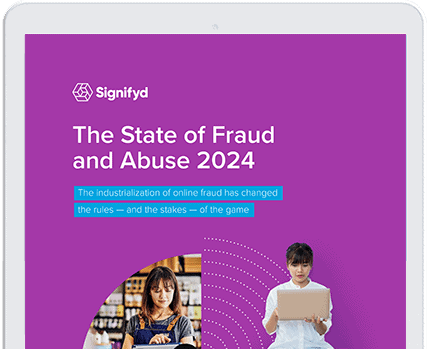Why should merchants care about promo abuse?
There was a time when “clipping coupons” was a virtuous pursuit. What could be more wholesome than putting in a little work to get a better deal?
But as happens in the rapidly evolving digital world, the admirable practice has taken something of a dark turn: Unscrupulous consumers and organized fraud rings are breaking retailers’ rules and finding ways to take unfair advantage of ecommerce promotional offers.
Promo abuse is a significant force behind a wave of first-party fraud and abuse that is pounding retailers like never before. Promo code abuse costs merchants billions — $89 billion annually by one estimate — and wreaks havoc with customer experience and brand reputation.
The cost of promo abuse
“It can cost merchants a lot of money,’’ said Signifyd Senior Manager, Risk Intelligence Xavi Sheikrojan. Especially when fraudsters and resourceful consumers combine promo abuse with other schemes.
Consider, for instance, an unauthorized reseller who unleashes bots to corner the market on a popular product before selling it at a premium on a marketplace. Buying large numbers of that must-have item at a discount boosts profit margins. Or think of a wardrober, who wants to buy a high-end fashion piece, wear it to one event and return it. A discount code might put that out-of-reach sticker price on a designer outfit within reach for that big night on the town.
What is promo abuse?
Promo abuse is a subset of first-party fraud and abuse, which is on the rise.
In fact, 45% of merchants surveyed by the Merchant Risk Council (MRC) for its 2024 Global Payments & Fraud report cited first-party misuse as a major headache. Only refund and policy abuse was named as a bigger problem by merchants.
We are all familiar with offers from merchants aimed at getting consumers to try out a product or service — some provide a discount, some might offer a two-for-one deal or maybe a gift to say thanks for giving the retailer a try. Other popular promotions include free trials, complimentary introductory subscriptions, and referral programs, in which a customer receives a discount for referring a new customer to a merchant.
Crafty consumers and professional fraud rings exploit such offers in a variety of ways. An existing customer might, for instance, sign up as a first-time customer many times over by creating duplicate or fake accounts. Or someone looking to game the system could create a second email account under an assumed name and refer that “person” to a merchant to land a promotional offer. In fact that new “person” could then refer another fake account to a merchant as a first-time customer. And on and on.
The fake account scam works for purchasing products or receiving gifts that are offered with the purchase of another item. Sometimes, Sheikrojan says, a fraudster will make a purchase, accept the gift and then return the original product — but not the gift.
Depending on the merchant and a bad actor’s understanding of the merchant’s policies and practices, a customer might be able to simply “stack” promo codes beyond the permitted number to engineer a deeper discount on a particular product. Some retailers allow customers to use more than one promotional code or coupon per purchase. Generally, however, the type and number of promotional offers allowed are limited.
Why is promo abuse growing
The growth of promo abuse mirrors the increase in other forms of first-party fraud and abuse. The MRC’s recent survey found that 63% of the 1,100 merchants polled had seen an increase in first-party misuse in the past year.
Criminal rings promoting fraud-as-a-service are part of the first-party abuse problem
Promo abuse is just one form of consumer abuse that is on the rise. The reasons for the increase are many. Signifyd Senior Manager, Risk Intelligence Xavi Sheikrojan digs into how professional crime rings offering fraud-as-a-service have helped drive the increase in first-party fraud.
Fraud experts have pointed to several factors behind the disturbing trend:
- Advances in protection against traditional fraud at the checkout have spurred fraud rings to look for other vulnerabilities in the online shopping journey.
- Fraud rings are growing more sophisticated and adopting a more business-like approach to fraud, including looking for new lines of business and new revenue streams.
- Among those new lines of business are “fraud-as-a-service” operations, which have primarily focused on return and refund abuse. Sheikrojan says the fraud-as-a-service providers are moving into other forms of fraud and abuse. These operations either coach consumers on how to cheat retailers or take on the dirty work of fraudulent refunds and other abuse in return for a cut of the profits.
- Economic stress and uncertainty, which has a segment of consumers either looking to live the good life without spending more or feeling so desperate they’re willing to disregard retailers’ policies.
“We should definitely not underestimate the return-and-abuse fraud as a service,” Sheikrojan said. “This is just the start when we hear and are talking about these fraud organizations.”
Preventing promo abuse with robust promo policies and strategies
As with most forms of consumer abuse, the first step in preventing promo abuse is to carefully consider the policies — in this case the policies a merchant wants to apply to its promotions. Once a merchant has determined the breadth of its promotional activity, it should clearly communicate its promo policies on its digital sites along with any promotion, whether digital or paper.
Of course, having rules and clearly communicating them isn’t going to get merchants very far with customers who are intent on cheating the system or fraud rings that make a living doing it.
Detecting and deterring promo abuse
There are steps merchants can take to spot promo abuse and reject the orders that include the misuse of promotional offers. As with all fraud, vigilance can go a long way in detecting abuse. Technology can also play a role in your promo abuse strategy. Innovative approaches to understanding the who and why behind a transaction can call out patterns that indicate abuse.
Merchants looking to stop promo abuse should consider:
- Creating a discount code tracking system that provides insight into multiple codes originating from one account, device or location. Merchants can also detect high-velocity use of promotional codes, a sign that the system is being gamed.
- Keep an eye on unusually heavy use of promo codes for a given item or campaign. It could simply be a sign of a successful campaign. Or heavy use of promo codes could also be a sign of an attack.
- Turn to a machine-learning model that can raise a red flag or reject orders when it detects patterns that have proven to be signs of promo abuse in the past.
Machine learning and a consortium model is a powerful counter to promo abuse
Senior risk intelligence manager Sheikrojan says that machine learning applied to a consortium of many merchants is one of the surest ways to derail promo abuse in real time.
“It’s really the power of connection,” he says. “You know, data sharing, collecting these insights across channels from global networks.”
Signifyd’s Decision Center, for instance, relies on a global network to gather intelligence on promo abuse and allows merchants to create policies that identify those trying to take advantage while allowing the merchant to reject the order if it falls outside of the merchant’s promo policies.
Fraudsters and promo abusers don’t stop at one merchant, Sheikrojan explains.
“They go beyond the data walls of that particular merchant. They commit abuse at merchant A. Then they’ll commit the same abuse at merchant B. You as a merchant don’t have visibility into that. But tapping into Signifyd’s data network will allow you to see abuse and prevent it before it becomes a bigger problem.”
The technology is a step forward and more will surely follow. Because let’s face it, consumers aren’t going back to the days of clipping coupons any more than fraudsters are going back to the days of focusing only on the checkout stage of online buying.
Looking to end the promo abuse party? Let’s talk.












